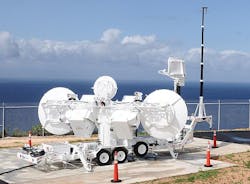JTE provides simulation of anti-aircraft missiles and other radar threats to military aircraft
Officials of the Air Force Life Cycle Management Center at Hill Air Force Base, Utah, announced a $10.4 million order Thursday for two wideband Joint Threat Emitter (JTE) units.
The JTE transmits RF signals that simulate single- and double-digit surface-to-air missiles and anti-aircraft artillery radar systems to provide training for combat aircrews by creating a modern, reactive battlespace war environment.
The JTE helps train military personnel to identify and counter enemy missile and artillery threats. It has a multi-threat, hi-fidelity simulator with realistic effective radiated power levels to help train combat aircrews to defeat or avoid integrated air defense systems (IADS) in a war-like training environment.
Related: Raytheon to upgrade radar signal processing for missile-defense system in Thule, Greenland
"When they go to a real-world situation, they won't see anything that we haven't thrown at them before," says Staff Sgt. Rick Woltkamp, 266th Range Squadron ground radar systems craftsman with the Idaho Air National Guard. "We simulate a ground attack, and the pilot will react and respond accordingly to the simulation."
A computer in the JTE collects data and evaluates the aircrew's response to simulated threat signals to evaluate their performance during their training sortie.
On this contract Northrop Grumman will do the work in Buffalo, N.Y., and should be finished by June 2019. For more information contact the Northrop Grumman Amherst Systems online at www.northropgrumman.com, or the Air Force Life Cycle Management Center at www.wpafb.af.mil/aflcmc.
Learn more: search the Aerospace & Defense Buyer's Guide for companies, new products, press releases, and videos
